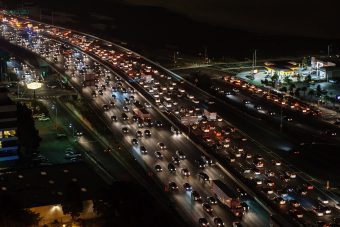- In 2019, US motorists drove equivalent of 337 round trips from Earth to Pluto.
- Lockdown meant a 64% drop in car usage, according to a KPMG report.
- 14 million fewer cars may be needed if working and shopping trends continue.
As many as 14 million cars could disappear from American roads in the wake of the coronavirus pandemic.

That’s one of the findings of a KPMG report that estimates almost 40% of all jobs in the United States could be done from home, drastically reducing reliance on the private motor vehicle.
In 2019, US motorists collectively covered a distance equivalent to 337 round trips from Earth to Pluto – around 4.8 trillion kilometres. But as much of the country, and indeed the rest of the world, went into various forms of lockdown, there was a 64% drop in car usage, KPMG found. That decline refers specifically to something called vehicle miles travelled (VMT), an industry measure of cumulative car journeys.
If that trend continues, Americans will drive 435 billion fewer kilometres per year. That’s a drop of just over 9%.
Mission control
KPMG refers to the most common reasons or ‘missions’ Americans have for car ownership. For around 40% of the country’s motorists, those missions are shopping and commuting.
The retail sector has been in a state of flux since the advent of ecommerce. For a growing number of shoppers, the convenience offered by online shopping has become increasingly important. Many brick-and-mortar retailers and large shopping destinations have closed in recent years, citing ecommerce as the cause for their decline.
For many shoppers, the lockdowns that accompanied the coronavirus pandemic were the impetus to increase their online spend. That may have been because physical stores were shut, or to maintain social distancing. But the effect, according to KPMG, was that footfall for non-essential retail fell by 80%. Some 60% of Americans said they were doing more shopping online than offline now, up from 44% pre-pandemic.
That is a trend that KPMG expects to see maintained over the longer term.
Work/life balance
The other mission KPMG referred to was commuting. Unsurprisingly, there was a major fall in commuting due to many businesses shutting their offices and sending staff home to work remotely.
Before the advent of lockdowns and shutdowns, just 3.4% of US workers were full-time home-workers. That shot up to 62% in early April. And while many have now begun to return to work, not all of them will.
Some businesses are adopting a steady-as-she-goes approach, continuing work-from-home procedures while evaluating changes to the economy and the spread of the infection. Amazon, Google, Microsoft, Salesforce and others are extending remote-working through to the end of 2020. Facebook, Slack and Twitter, have said staff who want to work from home permanently will be allowed to do so.
The total number likely to stay at home is still only an estimate. But KPMG thinks it could be between 13 million and 27 million staff – or 10% to 20% of the US workforce.
In March, 74% of respondents to a Gartner survey of more than 300 CFOs and heads-of-finance said they were shifting at least 5% of office staff to remote working.
There were around 273.6 million vehicles registered in the US in 2018. KPMG says that’s an average of 1.97 cars per household, which it anticipates could drop to 1.87 if its forecasts are correct. The cumulative effect of people driving less is that the equivalent of 14 million fewer cars will be needed. But this won’t automatically lead to the disappearance of that many automobiles from US highways. Instead, KPMG thinks there may be a gradual phasing out of second-car households, as the need for more than one vehicle becomes less pressing, which may in turn impact the vehicle sales sector and the wider automotive industry.
Source: WEF



